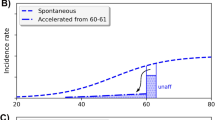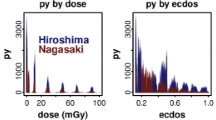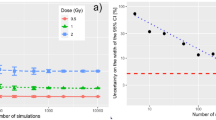Abstract
Breast cancer risk from radiation exposure has been analyzed in the cohort of Japanese a-bomb survivors using empirical models and mechanistic two-step clonal expansion (TSCE) models with incidence data from 1958 to 1998. TSCE models rely on a phenomenological representation of cell transition processes on the path to cancer. They describe the data as good as empirical models and this fact has been exploited for risk assessment. Adequate models of both types have been selected with a statistical protocol based on parsimonious parameter deployment and their risk estimates have been combined using multi-model inference techniques. TSCE models relate the radiation risk to cell processes which are controlled by age-increasing rates of initiating mutations and by changes in hormone levels due to menopause. For exposure at young age, they predict an enhanced excess relative risk (ERR) whereas the preferred empirical model shows no dependence on age at exposure. At attained age 70, the multi-model median of the ERR at 1 Gy decreases moderately from 1.2 Gy−1 (90% CI 0.72; 2.1) for exposure at age 25 to a 30% lower value for exposure at age 55. For cohort strata with few cases, where model predictions diverge, uncertainty intervals from multi-model inference are enhanced by up to a factor of 1.6 compared to the preferred empirical model. Multi-model inference provides a joint risk estimate from several plausible models rather than relying on a single model of choice. It produces more reliable point estimates and improves the characterization of uncertainties. The method is recommended for risk assessment in practical radiation protection.







Similar content being viewed by others
Notes
William of Occam’s (* 1287 near London, \(\dag\) 1347 in Munich) principle of parsimony or Occam’s razor is often phrased as pluralitas non est ponenda sine necessitate (plurality should not be posited without necessity).
References
Akaike H (1973) Information theory and extension of the maximum likelihood principle. In: Petrov N, Caski F (eds) Proceedings of the second international symposium on information theory. Akademiai Kiado Budapest, Hungary, pp 267–281
Althuis MD, Dozier JM, Anderson WF, Devesa SS, Brinton LA (2005) Global trends in breast cancer incidence and mortality 1973–1997. Int J Epidemiol 34:405–412
Anderson DR, Burnham KP, Gould WR, Cherry S (2001) Concerns about finding effects that are actually spurios. Wildl Soc Bull 29(1):311–316
Bernstein JL, Langholz B, Haile RW, Bernstein L, Thomas DC, Stovall M, Malone KE, Lynch CF, Olsen JH, Anton-Culver H, Shore RE, Boice JD Jr, Berkowitz GS, Gatti RA, Teitelbaum SL, Smith SA, Rosenstein BS, Børresen-Dale AL, Concannon P, Thompson WD (2004) Study design: evaluating gene-environment interactions in the etiology of breast cancer—the WECARE study. Breast Cancer Res 6:R199–R214
Bijwaard H, Brenner A, Dekkers F, van Dillen T, Land CE, Boice JD (2010) Breast cancer risk from different mammography screening practices. Radiat Res 174(3):367–376
Burnham KP, Anderson D (2002) Model selection and multimodel inference. 2nd edn. Springer, New York
Cheng J, Druzdzel M (2000) Latin hypercube sampling in Bayesian networks. In: FLAIRS-2000. Menlo Park, CA, pp 287–292
Claeskens G, Hjort NL (2008) Model selection and model averaging. Cambridge University Press, Cambridge
Clarke RB (2006) Ovarian steroids and the human breast: regulation of stem cells and cell proliferation. Maturitas 54(4):327–334
Clemmesen J (1948) Carcinoma of the breast. Br J Radiol 21(252):583–590
Cullings HM, Fujita S, Funamoto S, Grant EJ, Kerr GD, Preston DL (2006) Dose estimation for atomic bomb survivor studies: its evolution and present status. Radiat Res 166:219–254
De Michele A, Weber B (2000) Inherited genetic factors. In: Harris JR, Lippman ME, Morrow M, Osborne CK (eds) Disease of the breast, 2nd edn. Lippincott Williams & Wilkins, Philadelphia
Eidemüller M, Holmberg E, Jacob P, Lundell M, Karlsson P (2009) Breast cancer risk among Swedish hemangioma patients and possible consequences of radiation-induced genomic instability. Mutat Res 669:48–55
Eidemüller M, Ostroumova E, Krestinina L, Epiphanova S, Akleyev A, Jacob P (2010) Comparison of mortality and incidence solid cancer risk after radiation exposure in the Techa River Cohort. Radiat Environ Biophys 49:477–490
Heidenreich WF (1996) On the parameters of the clonal expansion model. Radiat Environ Biophys 35:127–129
Heidenreich WF, Cullings HM, Funamoto S, Paretzke HG (2007) Promoting action of radiation in the atomic bomb survivor carcinogenesis data. Radiat Res 168:750–756
Heidenreich WF, Jacob P, Paretzke HG (1997) Exact solutions of the clonal expansion model and their application to the incidence of solid tumors of the atomic bomb survivors. Radiat Environ Biophys 36:45–58
Heidenreich WF, Luebeck EG, Moolgavkar SH (1997) Some properties of the hazard function of the two-mutation clonal expansion model. Risk Anal 17:391–399
Hoeting JA, Madigan D, Raftery AE, Volinsky CT (1999) Bayesian model averaging: a tutorial. Stat Sci 14(4):382–417
Iman RL, Conover WJ (1982) A distribution-free approach to introduce rank correlations among input variables. Commun Stat 11:311–334
Jacob P, Meckbach R, Kaiser JC, Sokolnikov M (2010) Possible expressions of radiation-induced genomic instability, bystander effects or low-dose hypersensitivity in cancer epidemiology. Mutat Res 687:34–39
Jacob P, Walsh L, Eidemüller M (2008) Modeling of cell inactivation and carcinogenesis in the atomic bomb survivors with applications to the mortality from all solid, stomach and liver cancer. Radiat Environ Biophys 47:375–388
Jacob V, Jacob P (2004) Modeling of carcinogenesis and low-dose hypersensitivity: an application to lung cancer incidence among atomic bomb survivors. Radiat Environ Biophys 42:265–273
Kabuto M, Akiba S, Stevens RG, Neriishi K, Land CE (2000) A prospective study of estradiol and breast cancer in Japanese women. Cancer Epidemiol Biomarkers Prev 9:575–579
Kocher D, Apostoaei AI, Henshaw RW, Hoffman FO, Schubauer-Berigan MK, Stancescu DO, Thomas BA, Trabalka JR, Gilbert ES, Land CE (2008) Interactive radioepidemiological program (IREP): a web-based tool for estimating probability of causation/assigned share of radiogenic cancers. Health Phys 95(1):119–147
Land CE, Tokunaga M, Koyama K, Soda M, Preston DL, Nishimori I, Tokuoka S (2003) Incidence of female breast cancer among atomic bomb survivors, Hiroshima and Nagasaki, 1950–1990. Radiat Res 160:707–717
Little MP, Li G (2007) Stochastic modelling of colon cancer: is there a role for genomic instability?. Carcinogenesis 28(2):479–487
Moneta L, James F (2010) Minuit2 minimization package. http://seal.web.cern.ch/seal/snapshot/work-packages/mathlibs/minuit. V. 5.27.02, accessed 3 May 2011
Moolgavkar SH, Day NE, Stevens RG (1980) Two-stage model for carcinogenesis: epidemiology of breast cancer in females. J Natl Cancer Inst 65(5):559–569
Moolgavkar SH, Dewanji A, Venzon DJ (1988) A stochastic two-stage model for cancer risk assessment. I. The hazard function and the probability of tumor. Risk Anal 8(3):383–392
Moolgavkar SH, Luebeck G (1990) Two-event model for carcinogenesis: biological, mathematical, and statistical considerations. Risk Anal 10:323–341
Nekolla EA, Walsh L, Spiess H (2010) Incidence of malignant diseases in humans injected with radium-224. Radiat Res 174:377–386
Pierce DA, Væth M (2003) Age-time patterns of cancer to be anticipated from exposure to general mutagens. Biostatistics 4(2):231–248
Pike MC, Krailo MD, Henderson BE, Casagrande JT, Hoel DG (1983) Hormonal risk factors, breast tissue age and the age-incidence of breast cancer. Nature 303:767–770
Posada D, Buckley TR (2004) Model selection and model averaging in phylogenetics: advantages of Akaike information criterion and Bayesian approaches over likelihood ratio tests. Syst Biol 53(4):793–808
Preston DL, Mattsson A, Holmberg E, Shore R, Hildrethe NG, Boice JD (2002) Radiation effects on breast cancer risk: a pooled analysis of eight cohorts. Radiat Res 158:220–235
Preston DL, Pierce DA, Shimizu Y, Cullings HM, Fujita S, Funamoto S, Kodama K (2004) Effects of recent changes in atomic bomb survivors dosimetry on cancer mortality risk estimates. Radiat Res 162:377–389
Preston DL, Ron E, Tokuoka S, Funamoto S, Nishi N, Soda M, Mabuchi K, Kodama K (2007) Solid cancer incidence in atomic bomb survivors: 1958–1998. Radiat Res 168:1–64
Ronckers CM, Erdmann CA, Land CE (2005) Radiation and breast cancer: a review of current evidence. Breast Cancer Res 7:21–32
Shimizu H, Ross RK, Bernstein L, Pike MC, Henderson BE (1990) Serum oestrogen levels in postmenopausal women: comparison of American whites and Japanese in Japan. Br J Cancer 62:451–453
Sjöblom T, Jones S, Wood LD, Parsons DW, Lin J, Barber TD, Mandelker D, Leary RJ, Ptak J, Silliman N, Szabo S, Buckhaults P, Farrell C, Meeh P, Markowitz SD, Willis J, Dawson D, Willson JKV, Gazdar AF, Hartigan J, Wu L, Liu C, Parmigiani G, Park BH, Bachman KE, Papadopoulos N, Vogelstein B, Kinzler KW, Velculescu VE (2006) The consensus coding sequences of human breast and colorectal cancers. Science 13:268–274
Walsh L (2007) A short review of model selection techniques for radiation epidemiology. Radiat Environ Biophys 46:205–213
Walsh L, Kaiser JC (2011) Multi-model inference of adult and childhood leukaemia excess relative risks based on the Japanese a-bomb survivors mortality data (1950–2000). Radiat Environ Biophys 50:21–35
Yau C, Fedele V, Roydasgupta R, Fridlyand J, Hubbard A, Gray JW, Chew K, Dairkee SH, Moore DH, Schittulli F, Tommasi S, Paradiso A, Albertson DG, Benz CC (2007) Aging impacts transcriptomes but not genomes of hormone-dependent breast cancers. Breast Cancer Res 9:R59
Acknowledgments
This report makes use of data obtained from the Radiation Effects Research Foundation (RERF) in Hiroshima and Nagasaki, Japan. RERF is a private, non-profit foundation funded by the Japanese Ministry of Health, Labour and Welfare (MHLW) and the US Department of Energy (DOE), the latter in part through the National Academy of Sciences. The data include information obtained from the Hiroshima City, Hiroshima Prefecture, Nagasaki City, and Nagasaki Prefecture Tumor Registries and the Hiroshima and Nagasaki Tissue Registries. The conclusions in this report are those of the authors and do not necessarily reflect the scientific judgment of RERF or its funding agencies. The work has been supported by the German Federal Ministry of Environment, Nature Protection and Reactor Safety under contract number StSch4451. We would like to thank Linda Walsh for sharing ideas on multi-model inference, Markus Eidemüller for his computer code on LHS sampling and Helmut Schöllnberger for discussions on mechanistic models.
Author information
Authors and Affiliations
Corresponding author
Rights and permissions
About this article
Cite this article
Kaiser, J.C., Jacob, P., Meckbach, R. et al. Breast cancer risk in atomic bomb survivors from multi-model inference with incidence data 1958–1998. Radiat Environ Biophys 51, 1–14 (2012). https://doi.org/10.1007/s00411-011-0387-4
Received:
Accepted:
Published:
Issue Date:
DOI: https://doi.org/10.1007/s00411-011-0387-4




